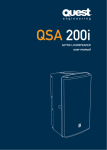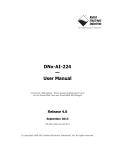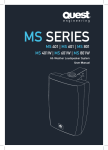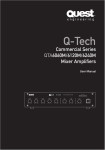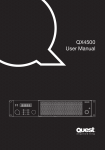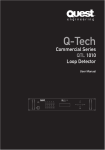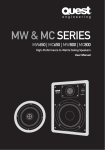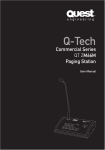Download Quest Engineering QSA 300 User manual
Transcript
QSA 300 ACTIVE SPEAKER User Manual QSA 300 User Manual CONTENTS Contents Safety Installation Connections Glossary Operating Tips Troubleshooting Inputs & Outputs Specifications Accessories User Manual QSA 300 Active Speakers P.01 P.02 P.03 P.04 P.05 P.06 P.07 P.08 P.09 QSA 300 User Manual Flying and installation of this speaker cabinet must be carried out by suitably qualified personnel following the approved safety standards. Do not expose the speaker cabinet to direct precipitation or stand in water. Liquid getting into the box will risk a short circuit and will be hazardous. Do not attempt to clean the plastic enclosure with solvents or petrochemical based cleaners. Do not stack the speaker cabinet in a manner that could cause injury should a cabinet become dislodged. The power voltages of the amplifiers inside these speakers are high and could cause serious injury or death if touched while the power is connected. Do not open the case as there are no user serviceable parts inside. o 30 c Do not place sources of heat on the speaker cabinet such as lighting equipment or smoke machines. 1 Attention Very important Before connecting or operating your new Quest Engineering speaker, please study the accompanying instruction manual paying particular attention to the operating precautions and wiring procedure. Before using your speaker check to make sure that the selection of the power supply voltage (115/230 Volts) is set correctly for your country. An incorrect setting can lead to severe damage to your new powered speaker on activation. If you are not certain that it is set correctly, check with your Quest Engineering dealer. Quest Engineering will not assume responsibility for incorrect installation or operation of this product. SAFETY Safety Precautions QSA 300 User Manual Active Speakers QSA 300 INSTALLATION User Manual 2 Description Safe Installation Procedures The QSA speaker range is a two way active bass reflex design suitable for mobile or installation use. The amplifiers are a highly efficient bi-polar split rail design capable of high power yet are light in weight. There are separate amplifiers for the high and low frequency drivers and both are protected by high speed limiter circuits that monitor peak and RMS power. The operation of these devices will not affect audio quality due to their advanced design. Limiters and compressors are not a substitute for sensible operation. The system will sound at its best when mixers and other signal processors in the audio chain are not being over driven into distortion. (a) Under no circumstances attach the box with less than two of the threaded inserts. (b) The speaker box must not be installed in a manner where the weight is not equally distributed between two insert points. Full Range or Mid-High Applications (c) One pair of threaded inserts may only carry the weight of one box. Therefore multiple box rigging from one pair of insert points should not be attempted. (d) The carry handle is not intended to be used as a flying point. Do not suspend over peoples heads with the handle as a flying point. (e) Do not locate boxes near sources of moisture or where water can enter the box. The design characteristics make the QSA series suitable for both full range use or as the high-mid component of a multi way system with sub-bass enhancement. Coupled with the Quest Engineering QSA 900 compact active sub-bass system they will provide high performance multi way audio system. (a) (b) Installation Temporary installation is possible with the 35mm floor stand mounting in the base of the enclosure. Foldback installation is possible with the addition of the floor monitor supplied. Optional metal monitor cradles are available from your Quest Engineering dealer. (e) Flying Installation Two M 8 thread inserts are located on the top and one under the QSA series enclosures. These are intended to be used with the designated “U” shaped bracket. QSA Range Flying Accessories QSA-FL 1 Wall bracket kit QSA-FL 2 Wall bracket vertical pole mount kit User Manual QSA 300 Active Speakers (c) (d) QSA 300 User Manual 10 6 8 11 7 14 15 12 16 4 9 13 CONNECTION 5 3 3 1 2 1. Power supply input. Make sure that the voltage selector is set for your Country’s correct voltage. 2. Protection fuse. Use only fuses of the correct Amp rating. If it blows more than once, return the box to a Quest Engineering service centre. 3. Power on/off switch. 4. Microphone level (low impedance) input. 5. Microphone balanced input volume control. 6. Microphone input overload indicator 7. Bass roll off for microphone input 8. Microphone input signal presence indicator 9. Line level balanced input. (To mixer or other +4 dB or less line level) 10. Line level volume control. 11. Line level input overload indicator. 12. Line level signal presence indicator. 13. Line out. This is a “buffered” output at a fixed level. 14. Master volume. 15. Clip/limit indicator. If this LED illuminates for more than an occasional flash, turn down the mixer output. If you need more volume, set up more speaker boxes. 16. Power amp active indicator. QSA 300 User Manual Active Speakers QSA 300 User Manual Pre amplifier: That part of the signal chain where a signal from a microphone, turntable, CD player or other signal source is first amplified. This will normally be at the input of a mixer and is necessary to boost the signal enough to be then mixed and amplified by a power amplifier. Compression: An electronic device that reduces the dynamic range. In other words, makes the loud parts of the music less loud and the quiet parts appear louder. When used correctly it can make live music sound more even and balanced. 10 Compressor Threshold Power amplifier: Boosts the signal enough so it can be reproduced by a loudspeaker. Electronic cross over: Splits up the full range audio signal to separate high and low frequencies. This is done to send low frequencies to the bass speaker and high frequencies to the tweeter or high frequency horn driver. Hi Freq. Amp 4 Electronic xover Hi Freq. Drive Input Signal Low Freq. Drive Low Freq. Amp Self powered: Refers to a speaker or a mixer that contains a power amplifier. Clipping: Distortion that is caused by having too much signal at an input causing the amplifier to overload. It is called clipping because it will cause a smooth wave to be cut off at the peak of the wave. In other words, “clipped” Clipping Clipping Gain structure: The relationship of input levels to output levels in a signal chain. An example of incorrect gain structure is when a mixer is turned up to the point of audible distortion (red lights flashing serious overload), and the power amplifiers are turned down and running at only 30% power. User Manual QSA 300 Active Speakers 3:1 1:1 10 Limiter: An electronic device that will prevent the signal from exceeding a set level of output. Normally used as a system protection to prevent it from being over driven by excessive input. 10 Limiter Threshold Output Level GLOSSARY Basic professional audio practice and hints for best results Output Level Glossary 0:1 1:1 10 Phase (in or out of phase): This really means speaker polarity. The input terminals of a normal loudspeaker have a + positive red terminal and a - negative black terminal. In the case where there are two speakers operating as a pair or together as an array, will need to all be wired the same way. If a speaker connecter, speaker lead or speaker box is wired in reverse to a box near it, loss of performance will result. This may be in the form of lost low frequency response. In this case you will see the bass speaker working hard but as you move away from the box, the bass frequencies will seem to “disappear”. Check that your speaker leads do not have one lead wired in reverse at one end and that the speaker boxes are all wired correctly internally. This can happen when a speaker box has been repaired and then not assembled with the wiring connected correctly. QSA 300 Operating tips To avoid overloading the pre amp inputs, always operate the master volume at a high level and control the volume from the input volume. The ideal situation is to have all the components of the audio chain operating at the same operational range. Do not run the system with the mixer “peaking in the red” while the box is turned down. MIXER AMP 10 10 5 5 5 1 1 0 1 2 Also do not operate the system with the input peaking (red overload light on or flashing) and the master volume turned down. Red lights flashing on a mixer indicate distortion. If you have a mixer with the facility to show you the input level on a meter, for example then you push a CUE/PFL button, set the input level to below the level of the red end of the LED ramp. If you run the row of red lights to the end of the ramp you will cause distortion at the very start of the pre amplifier stage of the mixer. At this point it will sound dirty and “fizzy” regardless of how good the rest of your sound system is. The rest of the system will be reproducing a distorted sound. If you need more volume, turn down the input signal so it is out of the red and turn up the output of the mixer. 10 CLIP/LIMIT MIXER AMP 10 10 5 5 5 1 1 0 1 2 MIXER AMP 10 10 5 5 5 1 1 0 1 10 CLIP/LIMIT OPERATING TIPS User Manual 5 10 CLIP/LIMIT 2 QSA 300 User Manual Active Speakers QSA 300 User Manual TROUBLESHOOTING Trouble shooting 6 Buzzes and noises in the sound system. Getting rid of unwanted noises is a study in itself. Most of the noise, (apart from undesirable program) will fall into three categories. (A) White noise. This is the hiss that suggests that the gain structure is set incorrectly. Something in the signal chain is boosting too much or an input is set too sensitive. If your equipment has gain switches on it, set them all the same. If the switch is labelled +4dB, set them all to that figure. If one piece of equipment seems to be overloading, set them all to -10/-20dB and be prepared to boost the input level of the QSA input. The last unit in the chain should be set to +4 dB at the output stage if possible when connected to the line level input of the QSA series input. (B) Low frequency hum. This is often caused by noise from the power leads being picked up by the audio signal cables. The preferred solution is to connect up your system with “balanced” XLR microphone cables. Especially if you are running the cables a long distance, (more than 5Mtrs /15 Ft). The other solution is to make sure that your audio cables are as far from power cables as possible. User Manual QSA 300 Active Speakers (C) Buzz. Sometimes you can experience a hum and buzz together. A buzz is almost always a problem with the “earthing” of the system. It will often occur when you have the system powered from sperate power outlets in the same building or audio and lighting sharing a common power circuit. Even when the audio and lighting systems are powered from separate sources, there can still be a common earth between them. For example, a smoke machine may be powered from the lighting system, yet the trigger mechanism could be connected to the audio system through the audio multi-core/snake. An earth connection between the audio and lighting will now exist and a buzz could be amplified in the audio system. The simple solution is to power your audio circuit and everything connected to it from the same source. If the buzz persists, check your signal cables, one may have an earth/shield disconnected. A cheap but possibly life saving investment is a domestic power tester to check that the power supply sockets are correctly wired. Faulty or incorrectly wired power is a booby trap that is more common than you think. It is wise to avoid switching on or off devices in the signal path while the speaker system is powered and turned up. Otherwise loud clicks and bangs could result. When shutting down the system, always turn the speakers off first. This is to prevent the speaker amplifying the sound of the other equipment in the chain being shut down. The reverse is true when powering up. Mixers and effects on first, power amplifiers or powered speakers on last. QSA 300 Inputs and outputs The inputs can accept both XLR and phono connectors. If you are connecting multiple boxes together is unprofessional practice to use a mixture of both phono and XLR types of leads. Use one or the other otherwise an out of phase situation can result. Tips on “flying clusters” When very high output or broad coverage is required, it is common practice to assemble an array of speakers together. In a flown horizontal array of high/mid configured speakers, best results are obtained by angling the boxes apart slightly at the front of the array while the rear of the boxes must be together on the same vertical plane. The purpose is to minimise phase shift and interference effects between the boxes. If two boxes are directing acoustic energy into the same coverage area, loss of smooth frequency response will result. This is called “lobing” as “fingers” of both frequency peaks and dips spread out across the coverage area, especially at the area where the signal from the overlapping coverage converges. INPUTS/OUTPUTS User Manual 7 QSA 300 Gig Array QSA 300 User Manual Active Speakers QSA 300 User Manual SPECIFICATIONS Quest Engineering QSA 300 Specifications* 8 Type Self contained bi-amplified bass reflex Loudspeakers 1 diameter 300mm (12”) woofer High powered 80mm (3”) voice coil Titanium diaphragm Angle of Coverage 90 X 60 degrees Maximum SPL 123 dB (Nominal) 127 dB (Peak) Processor section Crossover frequency 1800 Hz (24dB/oct) Loudspeaker protection Thermal - over excursion - multi band input limiting Amplifier section Type Fully discrete bi-polar split rail high efficiency design Low frequency Nominal 240W Music power 450W High frequency Nominal 60W Music power 110W Distortion Less than 0.1% 1K-10K - nominal power Input XLR-Phono balanced MICRO level -30dB volume pot (80 Hz roll off switch) XLR-Phono balanced LINE level +4 Volume pot Output XLR fixed line level electronically buffered LED Indicators Signal presence Micro/Line - Input overload Micro/Line - Power amplifier - Clip/Limit Controls Microphone - Line - Master volume - Low frequency roll off Power Supply 115/230 Vac (+ 7%) - 50/60 Hz / 400VA Cabinet Flying Points 4 x M8 on top, bottom and rear sides. Dimensions 450 x 360 x 690 mm Packing Dimensions 505 x 410 x 755 mm Net Weight 23 Kg (57 lbs) Shipping Weight 27 Kg (62 lbs) * Quest Engineering reserves the right to make changes in specifications, or products without prior notice. User Manual QSA 300 Active Speakers QSA 300 User Manual Accessories QB350 QSSAL Protective nylon padded speaker bag Heavy duty aluminium speaker stand with carry bag ACCESSORIES Accessories 9 QSA 300 User Manual Active Speakers www.questaudio.net












